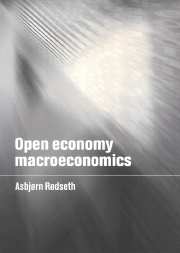Book contents
- Frontmatter
- Contents
- List of figures
- List of tables
- Preface
- List of standard symbols
- Introduction
- Part 1 Financial markets
- Part 2 The open economy
- 5 The extremely open economy
- 6 Home and foreign goods
- 7 Traded and non-traded goods
- 8 Alternative market structures, purchasing power parity and monopolistic competition
- Part 3 Policy issues
- Appendixes
- Notes
- Bibliography
- Index
8 - Alternative market structures, purchasing power parity and monopolistic competition
Published online by Cambridge University Press: 06 July 2010
- Frontmatter
- Contents
- List of figures
- List of tables
- Preface
- List of standard symbols
- Introduction
- Part 1 Financial markets
- Part 2 The open economy
- 5 The extremely open economy
- 6 Home and foreign goods
- 7 Traded and non-traded goods
- 8 Alternative market structures, purchasing power parity and monopolistic competition
- Part 3 Policy issues
- Appendixes
- Notes
- Bibliography
- Index
Summary
Chapters 5–7 were distinguished by different assumptions about market structure. In chapters 5 and 6 all goods were traded internationally, while chapter 7 allowed for non-traded goods. In chapters 5 and 7 all internationally traded goods had exogenously given world market prices, in chapter 6 export prices were affected by domestic cost and demand conditions. These approaches should not be seen as mutually exclusive and competing. In going from chapter 5 to chapter 7 we also went from the simple to the more general. An even more general and realistic model would combine chapters 6 and 7 and include non-traded goods, some traded goods where the home country is a price taker and some traded goods where it has market power. Quantitative macroeconomic models of open economies are often of this kind. However, such models usually require numerical solutions. One purpose of the present book is to give insight into the different mechanisms that are at work in such models, and in the real economy, by treating them more in isolation.
The demand and supply elasticities in international markets and the extent to which industries are sheltered against foreign competition are important for the quantitative effects of domestic demand and domestic wage costs. We saw that already in connection with the Marshall-Lerner condition.
- Type
- Chapter
- Information
- Open Economy Macroeconomics , pp. 260 - 284Publisher: Cambridge University PressPrint publication year: 2000



